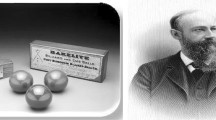Abstract
Bioplastics are eco-friendly and derived from renewable biomass sources. Innovation in recycling methods will tackle some of the critical issues facing the acceptance of bioplastics. Polylactic acid (PLA) is the commonly used and well-studied bioplastic that is presumed to be biodegradable. Considering their demand and use in near future, exploration for microbes capable of bioplastic degradation has high potential. Four PLA degrading strains were isolated and identified as Penicillium chrysogenum, Cladosporium sphaerospermum, Serratia marcescens and Rhodotorula mucilaginosa. A consortium of above strains degraded 44 % (w/w) PLA in 30 days time in laboratory conditions. Subsequently, the microbial consortium employed effectively for PLA composting.

Similar content being viewed by others
References
Sakai K, Kawano H, Iwami A, Nakamra M, Moriguchi M (2001) Isolation of a thermophilic poly l-lactide degrading bacterium from compost and its enzymatic characterization. J Biosci Bioeng. doi:10.4014/jmb.1105.05016
Tomita K, Tsuji H, Nakajima T, Kikuchi Y, Ikarashi K, Kieda N (2003) Degradation of poly (d-lactic acid) by a thermophile. Polym Degrad Stab. doi:10.1016/j.polymdegradstab.2003.12.006
Tomita K, Nakajima T, Kikuchi Y, Miwa N (2004) Degradation of poly (l-lactic acid) by a newly isolated thermophile. Polym Degrad Stab. doi:10.1016/j.polymdegradstab.2003.12.006
Kim MN, Kim WG, Weon HY, Lee SH (2007) Poly (l-lactide)-degrading activity of a newly isolated bacterium. J Appl Polym Sci. doi:10.1002/app.26658
Jarerat A, Pranamuda H, Tokiwa Y (2002) Poly (l-lactide)-degrading activity in various actinomycetes. Macromol Biosci. doi:10.1002/mabi.200290001
Tokiwa Y, Calabia BP, Ugwu CU, Aiba S (2009) Review: biodegradability of plastics. Mol Sci Int J. doi:10.3390/ijms10093722
Williams DF (1981) Enzymic hydrolysis of polylactic acid. Eng Med. doi:10.1243/EMED_JOUR_1981_010_004_02
Lee SH, Kim IY, Song WS (2014) Biodegradation of polylactic acid (PLA) fibers using different enzymes. Macromol Res. doi:10.1007/s13233-014-2107-9
Nair NR, Nampoothiri KM, Pandey A (2012) Preparation of poly (l-lactide) blends and biodegrdation by Lentzea waywayandensis. Biotechnol Lett. doi:10.1007/s10529-012-1005-5
Sambrook J, Fritsch EF, Maniatis T (1989) Molecular cloning: a laboratory manual, 2nd edn. Cold Spring Harbor Laboratory, New York
Seneviratne G (2003) Development of ecofriendly, beneficial microbial biofilms. Curr Sci 85:1395–1396
Patel SKS, Kumar P, Mehariya S, Purohit HJ, Lee JK, Kalia VC (2014) Enhancement in hydrogen production by co-cultures of Bacillus and Enterobactor. Int J Hydrog Energy. doi:10.1016/j.ijhydene.2014.07.084
Barker SB, Summerson WH (1941) The colorimetric determination of lactic acid in biological materials. J Biol Chem 138:535–554
Kumar D, Kumar L, Nagar S, Raina C, Parshad R, Gupta VK (2012) Isolation, production and application of lipase/esterase from Bacillus sp. strain DVL43. J Microbiol Biotech Res 521–528
Kimura T, Ishida Y, Ihara N, Saito Y (2002) Degradability of biodegradable plastic (poly(lactic acid)) products. J Jpn Soc Agric Mach 64:115–120
Hakkarainen M, Karlsson S, Albertsson AC (2000) Rapid (bio) degradation of polylactide by mixed culture of compost microorganisms—low molecular weight products and matrix changes. Polymer. doi:10.1016/S0032-3861(99)00393-6
Rahmouni M, Chouinard F, Nekka F, Lenaerts V, Leroux JC (2001) Enzymatic degradation of cross-linked high amylose starch tablets and its effect on in vitro release of sodium diclofenac. Eur J Pharm Biopharm. doi:10.1016/S0939-6411(01)00127-8
Liu L, Li S, Garrea H, Verti M (2000) Selective enzymatic degradations of poly (l-lactide) and poly (ε-caprolactone) blend films. Biomacromolecules. doi:10.1021/bm000046k
Acknowledgments
This work is financially supported by CSIR, New Delhi under the XIIth Five year plan Net work project Waste to Wealth (CSC 0120).
Author information
Authors and Affiliations
Corresponding author
Additional information
Nimisha R. Nair and Vini C. Sekhar have contributed equally to this work.
Electronic supplementary material
Below is the link to the electronic supplementary material.
Rights and permissions
About this article
Cite this article
Nair, N.R., Sekhar, V.C. & Nampoothiri, K.M. Augmentation of a Microbial Consortium for Enhanced Polylactide (PLA) Degradation. Indian J Microbiol 56, 59–63 (2016). https://doi.org/10.1007/s12088-015-0559-z
Received:
Accepted:
Published:
Issue Date:
DOI: https://doi.org/10.1007/s12088-015-0559-z




